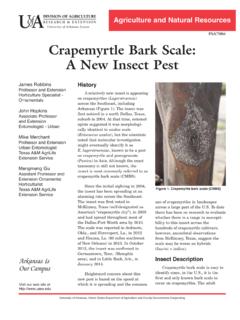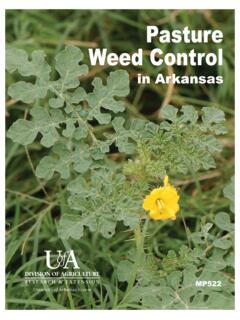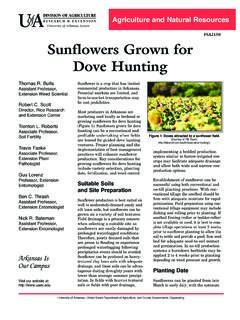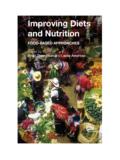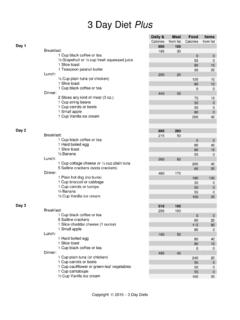Transcription of Feeding Broiler Litter - FSA3016
1 DIVISION OF AGRICULTURE R E S E A R C H & E X T E N S I O N University of Arkansas System Agriculture and Natural Resources FSA3016 Feeding Broiler Litter to Beef Cattle Shane Gadberry Associate Professor -Animal Science Arkansas Is Our Campus Visit our web site at: Cattle and other ruminants have a unique digestive system that allows them to use by products as sources of dietary nutrients. The cattle Feeding industry has been built largely using by products and other materials that can be digested only by ruminants. One by product which can be used as a cattle feed is Broiler Litter . Litter is a good source of protein, energy and minerals, especially for brood cows and stocker cattle.
2 Beef producers can use large amounts of Broiler Litter , provided that it is of reasonably good quality and suitable for Feeding . Throughout the country, Broiler Litter has been used as feed for more than 40 years without any recorded harmful effects on humans who have consumed the product of these animals. So, the possibility of any human health hazard, either real or imagined, is remote. Broiler Litter as a cattle feed offers three primary advantages: 1. It is an environmentally responsible use of a by product. 2. It provides an incentive for the proper management of this by product by poultry and cattle producers alike. 3. It economizes the production of beef cattle.
3 Regulations on Feeding Litter In 1967, when the FDA issued a policy statement which discouraged the Feeding of Litter and other types of animal wastes, there was relatively little knowledge available on Feeding Broiler Litter . In 1980, after exten sive testing by researchers at univer sities and USDA facilities, the FDA rescinded its earlier policy statement and announced that the regulation of Litter should be the responsibility of the state departments of agriculture. Presently, no federal laws or regulations control the sale or use of Broiler Litter as a feed ingredient. However, federal law (1996 feed rule) prohibits Feeding ruminant meat and bone meal back to ruminants.
4 As a result, Litter derived from flocks fed ruminant meat and bone meal as a component of the diet should not be fed to cattle. Several states have regulations that govern the sale through commercial markets of these products intended for sale as a feed ingredient. The beef producer, regardless of government regulation of the feed stuffs used, has the responsibility of selling a wholesome animal that is free from drugs and toxic substances. To minimize risks from drug residues in the tissues of beef cattle that are fed Litter , all Litter University of Arkansas, United States Department of Agriculture, and County Governments Cooperating Feeding should be discontinued two weeks before the animals are marketed for slaughter.
5 Litter should not be fed to lactating dairy cows, because there is no opportunity for a withdrawal period to ensure the elimination of residues from milk. Because of the sensitivity of sheep to copper, Litter containing high concentrations of copper should not be fed to these animals. Feeding alum (aluminum sulfate) treated Litter to cattle Beef cattle Feeding trials with alum treated Litter have shown mixed results. Alum binds phosphorus and may result in a phosphorus deficiency. Further research is needed on the Feeding value of Litter treated with additives that reduce environmental emissions. Avoid Feeding treated Litter if possible. Feeding PLT treated Litter to cattle PLT is a common name for a poultry Litter treatment product used to control ammonia in poultry houses.
6 The chemical component of PLT is sodium bisulfate. Sodium bisulfate is approved for use in pet foods, and although not practical, PLT could be applied when poultry houses are occupied. Research comparing Feeding PLT amended Litter to non amended Litter has not been published in scientific literature. However, given the application conditions and approval for use in pet food, sodium bisulfate would likely pose less of a production risk in comparison to the excessive mineral content of Litter . Nutritional Value of Broiler Litter Bedding materials used in Broiler houses include straw, wood shavings, sawdust and rice hulls. Poultry house owners use these products in varying amounts for the initial bedding and as additional bedding after each batch of birds.
7 The bedding material alone is a low quality feed ingredient. However, with the addi tion of feathers, wasted feed and excrement from the birds, the nutrient quality of the Litter improves. The kind of bedding material used in a Broiler house has little effect on the quality of the Litter when it is used for Feeding cattle. Because the amount of bedding used and the number of batches of birds housed on the Litter are not standardized or regu lated, Litter quality can vary considerably from one producer to another. Other factors such as Broiler house management, the method of Litter removal and moisture content can add to the variation in Litter composition and quality. The average nutrient content of Broiler Litter is shown in Table 1.
8 Moisture The amount of moisture in Broiler Litter is determined by the management of watering systems in the Broiler house. The moisture content of the Table 1. Nutrient Content of Broiler Litter (Dry Matter Basis) Nutrients No. Samples Average Range Dry Matter, ! 222 79 54-96 Total Digestible Nutrients, ! 222 50 33-57 Crude Protein, ! 222 23 12-35 Bound Nitrogen, !1 106 15 5-64 Crude Fiber, !1 106 24 11-52 Acid Detergent Fiber, ! 222 28 12-51 Minerals Calcium, ! 46 . Phosphorus, ! 47 Potassium, ! 45 Magnesium, ! 39 .7 . Sulfur, ! 37 .9 . Copper, ppm 42 569 75-1149 Iron, ppm 38 453 22-2185 Manganese, ppm 38 718 512-1083 Zinc, ppm 34 509 331-947 Ash (minerals)1 106 25 9-54 1 Values of Broiler Litter samples collected throughout Alabama.
9 All of the other values shown were from Broiler Litter samples collected throughout Arkansas. Litter does not vary significantly between fresh Litter and Litter that has been stacked for six months. Though moisture content is not an important measure of nutrient value, it will determine the physical quality of the feed. If the moisture content of a feed mix is 25 percent or more, it will not flow easily through an auger. However, if the Broiler Litter is 12 percent moisture or less, the ration may be dusty and less palatable to cattle. Litter should con tain at least 20 percent moisture to process properly. TDN Total Digestible Nutrients (TDN) value of Broiler Litter is fairly low in comparison to grain.
10 However, Litter that has a calculated value of 50 percent TDN is comparable to medium quality hay. Litter could be a valuable source of energy for both stocker cattle and brood cows. Crude Protein The crude protein in Broiler Litter is usually a very inexpensive source of protein for cattle. The average crude protein level of the samples analyzed was 23 percent. More than 40 percent of the crude protein in Litter can be in the form of non protein nitrogen. The non protein nitrogen is mostly uric acid which is excreted by poultry. Young ruminants do not utilize non protein nitrogen as readily as more mature beef cattle. So, for best performance, feed Broiler Litter to beef cattle weighing over 400 pounds.





